HP8920A综合测试仪使用说明
- 格式:pdf
- 大小:103.06 KB
- 文档页数:2
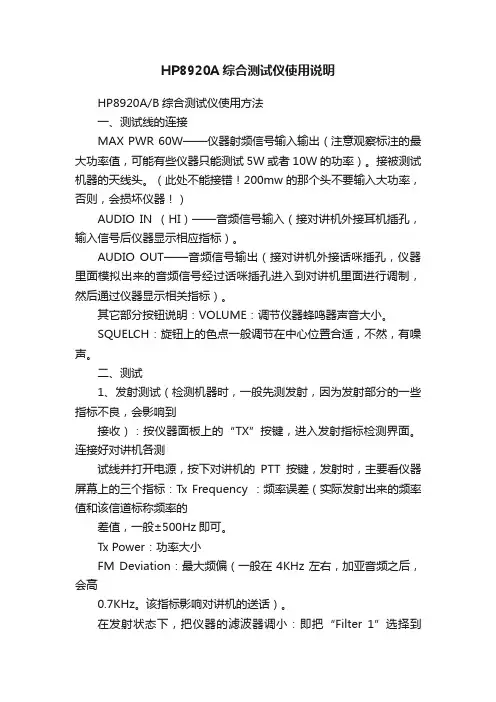
HP8920A综合测试仪使用说明HP8920A/B综合测试仪使用方法一、测试线的连接MAX PWR 60W——仪器射频信号输入输出(注意观察标注的最大功率值,可能有些仪器只能测试5W或者10W的功率)。
接被测试机器的天线头。
(此处不能接错!200mw的那个头不要输入大功率,否则,会损坏仪器!)AUDIO IN (HI)——音频信号输入(接对讲机外接耳机插孔,输入信号后仪器显示相应指标)。
AUDIO OUT——音频信号输出(接对讲机外接话咪插孔,仪器里面模拟出来的音频信号经过话咪插孔进入到对讲机里面进行调制,然后通过仪器显示相关指标)。
其它部分按钮说明:VOLUME:调节仪器蜂鸣器声音大小。
SQUELCH:旋钮上的色点一般调节在中心位置合适,不然,有噪声。
二、测试1、发射测试(检测机器时,一般先测发射,因为发射部分的一些指标不良,会影响到接收):按仪器面板上的“TX”按键,进入发射指标检测界面。
连接好对讲机各测试线并打开电源,按下对讲机的PTT按键,发射时,主要看仪器屏幕上的三个指标:Tx Frequency :频率误差(实际发射出来的频率值和该信道标称频率的差值,一般±500Hz即可。
Tx Power:功率大小FM Deviation:最大频偏(一般在4KHz左右,加亚音频之后,会高0.7KHz。
该指标影响对讲机的送话)。
在发射状态下,把仪器的滤波器调小:即把“Filter 1”选择到“<20Hz”,再把“Filter 2”选择到“300Hz”,即可以在“FM Deviation”这一栏直接查看到该信道所加的模拟亚音频数值。
2、接收测试:按仪器面板上的“RX”按键,在该界面,要设置以下参数:转动面板上的那个大的旋钮,让光标停留在“RF Gen Freq”处,直接按数字键和单位按键,即输入要测试对讲机的接收频率(如458.825MHz),然后,再把光标移到“Amplitude”这一项,分别输入1mv和0.25uv两种场强参数(看你自己的习惯,也可以用“-DBm”的单位),以检测机器的失真度和灵敏度。
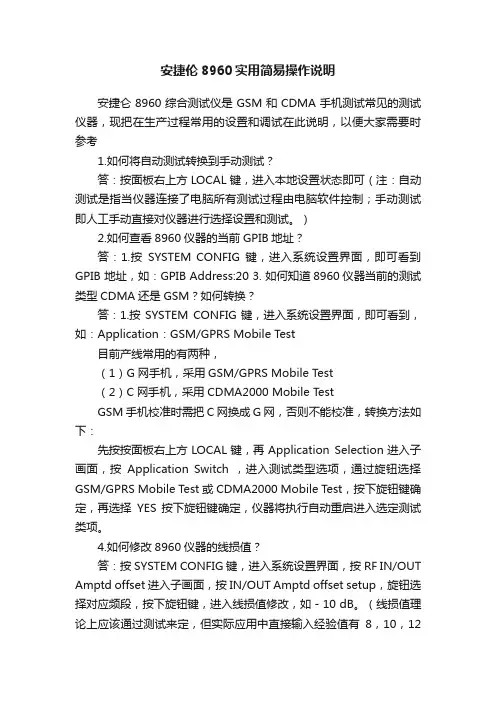
安捷伦8960实用简易操作说明安捷仑8960综合测试仪是GSM和CDMA手机测试常见的测试仪器,现把在生产过程常用的设置和调试在此说明,以便大家需要时参考1.如何将自动测试转换到手动测试?答:按面板右上方LOCAL键,进入本地设置状态即可(注:自动测试是指当仪器连接了电脑所有测试过程由电脑软件控制;手动测试即人工手动直接对仪器进行选择设置和测试。
)2.如何查看8960仪器的当前GPIB地址?答:1.按SYSTEM CONFIG键,进入系统设置界面,即可看到GPIB 地址,如:GPIB Address:20 3. 如何知道8960仪器当前的测试类型CDMA还是GSM?如何转换?答:1.按SYSTEM CONFIG键,进入系统设置界面,即可看到,如:Application:GSM/GPRS Mobile Test目前产线常用的有两种,(1)G网手机,采用GSM/GPRS Mobile Test(2)C网手机,采用CDMA2000 Mobile TestGSM手机校准时需把C网换成G网,否则不能校准,转换方法如下:先按按面板右上方LOCAL键,再Application Selection进入子画面,按Application Switch ,进入测试类型选项,通过旋钮选择GSM/GPRS Mobile Test或CDMA2000 Mobile Test,按下旋钮键确定,再选择YES 按下旋钮键确定,仪器将执行自动重启进入选定测试类项。
4.如何修改8960仪器的线损值?答:按SYSTEM CONFIG键,进入系统设置界面,按RF IN/OUT Amptd offset进入子画面,按IN/OUT Amptd offset setup,旋钮选择对应频段,按下旋钮键,进入线损值修改,如-10 dB。
(线损值理论上应该通过测试来定,但实际应用中直接输入经验值有8,10,12dB,使OK手机测试功率在33±3dB之内即可.5.如何用8960测试手机发射功率?答:在待机界面,按Mesutement Selection 进入弹出窗口,用旋钮选择功率***POWER 项,注意:GSM900M频段测试功率等级有5——15级, GSM1800M频段测试功率等级有0—15级,GSM900测试信道:1—124(中间信道62);GSM1800测试信道: 512—885(中间信道698),通话测试时:900M功率等级选最大5,信道选62,功率标准为33±3dB;1800M功率等级选最大0,信道选698,功率标准为33±3dB6.GSM手机接收灵敏度测试用手机建立一个呼叫连接,按下Measurement selection键(测试项目选择),选择测量项GSM Bit Error(误码),按下F7(BCH),再按F7调节Cell Power(信元功率),当Bit Error(误码)不超过2.4%时,Cell Power的值即为所测手机的接收灵敏度,国标为-102 dBm。
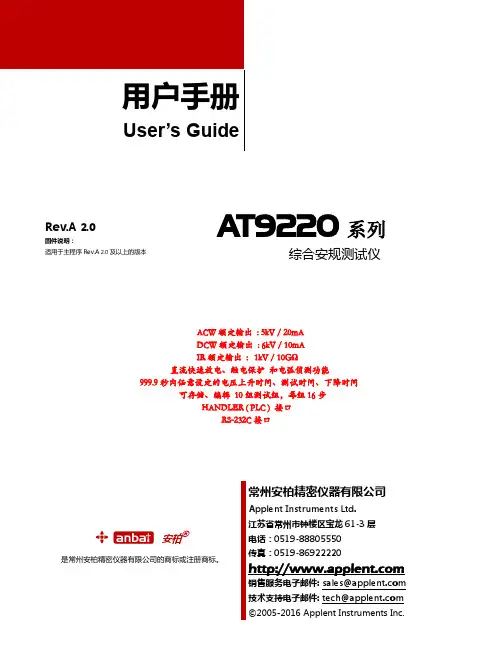
Rev.A 2.0固件说明:适用于主程序Rev.A 2.0及以上的版本AT9220系列综合安规测试仪ACW额定输出: 5kV / 20mADCW额定输出: 6kV / 10mAIR额定输出:1kV / 10GΩ直流快速放电、触电保护和电弧侦测功能999.9秒内任意设定的电压上升时间、测试时间、下降时间可存储、编辑10组测试组,每组16步HANDLER ( PLC ) 接口RS-232C接口& % 安柏®是常州安柏精密仪器有限公司的商标或注册商标。
安全须知当你发现有以下不正常情形发生,请立即终止操作并断开电源线。
立刻与安柏科技销售部联系维修。
否则将会引起火灾或对操作者有潜在的触电危险。
●仪器操作异常。
●操作中仪器产生反常噪音、异味、烟或闪光。
●操作过程中,仪器产生高温或电击。
●电源线、电源开关或电源插座损坏。
●杂质或液体流入仪器。
安全信息为避免可能的电击和人身安全,请遵循以下指南进行操作。
免责声明用户在开始使用仪器前请仔细阅读以下安全信息,对于用户由于未遵守下列条款而造成的人身安全和财产损失,安柏科技将不承担任何责任。
仪器接地为防止电击危险,请连接好电源地线。
不可在爆炸性气体环境使用仪器不可在易燃易爆气体、蒸汽或多灰尘的环境下使用仪器。
在此类环境使用任何电子设备,都是对人身安全的冒险。
不可打开仪器外壳非专业维护人员不可打开仪器外壳,以试图维修仪器。
仪器在关机后一段时间内仍存在未释放干净的电荷,这可能对人身造成电击危险。
不可在有强烈磁场或者电场的地方使用该仪器,电磁脉冲会引起仪器故障产生火灾。
在强烈磁场环境使用该仪器不要如果在本仪器的附近使用这些设备,被测件失效击穿产生的噪声也许会影响这些设备。
在敏感的测试设备和超过3kV的测试电压,测试线间的电场会电离空气产生电晕,在测试线之间产生大量接受设备附近使用该仪器的射频带宽的干扰。
为了减少这种影响,确保测试线之间的距离足够远。
另外,保持测试线远离导电表面(特别是尖鋭的金属末端)。
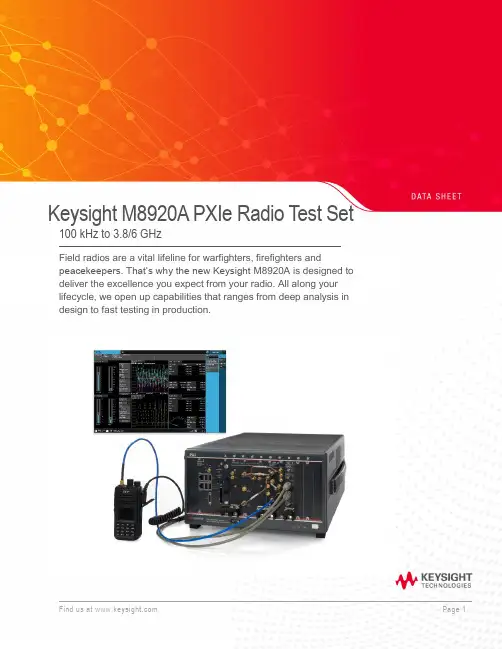
Keysight M8920A PXIe Radio Test Set 100 kHz to 3.8/6 GHzField radios are a vital lifeline for warfighters, firefighters andpeacekeepers. That’s why the new Keysight M8920A is designed to deliver the excellence you expect from your radio. All along your lifecycle, we open up capabilities that ranges from deep analysis in design to fast testing in production.Table of ContentsAccelerate MilCom and public safety radio manufacturing (3)Applications (3)Technical Specifications (4)Definitions and conditions (4)RF Analyzer Technical Specifications and Characteristics (5)RF Analyzer Technical Specifications and Characteristics (Continued) (6)RF Generator Technical Specifications and Characteristics (7)RF Generator Technical Specifications and Characteristics (Continued) (8)Audio Module Technical Specifications and Characteristics (8)Audio Module RX Audio Filters (9)Radio Test Application Specifications (9)N9093EM0E basic analog demodulation measurement application key specifications (9)N9093EM1E basic digital demodulation measurement application key specifications (9)Connectivity Test Application Specifications (10)WLAN 802.11ac (10)LTE-FDD/TDD (10)Bluetooth (10)Front Panel M9470A RF Interface Module Connections (10)General Specifications (11)Related Literature (12)Additional Information (12)Accelerate MilCom and public safety radio manufacturingDigital 2-way radios being developed for MilCom and the public safety radio market bring new testing challenges and hurdles to overcome for manufacturers and depot testing. Radio technologies are requiring wider bandwidths, higher frequencies, and multiple radio format capabilities.Product descriptionKeysight’s M8920A PXIe Radio Test Set supports many formats by combining PXI hardware with application-specific software in a single flexible and scalable chassis, providing broad multi-format coverage for next-generation radio testing.With Keysight’s new Radio Test Measurement Application (N9093), you can access and control multiple instruments on one screen while viewing a variety of critical measurements at the same time. Keysight can help deliver the operational excellence you expect from your radio.Applications−Cover all necessary analog AM and FM modulation test requirements.−Test APCO P1/P2, TETRA1, DMR, dPMR, ARIB, and custom modulation formats.−Test commercial connectivity formats including WLAN, LTE, Bluetooth®, etc.−All measurements can be performed with one click of a button.−Test analog Avionics Radios, and your Avionics Databus with optional Databus modulesM8920A PXIe Radio Test SetTechnical SpecificationsDefinitions and conditionsSpecifications describe the warranted performance of calibrated instruments. Data represented in this document are specifications under the following conditions unless otherwise noted.−Specifications are valid from 40° to 65 °C for individual module temperature, as reported by the module, and 20° to 35 °C for environment temperature unless otherwise noted −Calibrated instrument has been stored for a minimum of 2 hours within the allowed operating range−If instrument has previously been stored at a temperature range inside the allowed storage range, but outside the allowed operating range, instrument must have been stored for a minimum of 2hours within the allowed operating range before turn-on−30-minute warm-up time−Calibration cycle maintained−The RF, IF, and Source Alignments have been run within the previous 7 days−An ALL Alignment has been run within the previous 8 hours−If the temperature has changed more than 5 °C from the previous ALL AlignmentTypical describes additional product performance information that is not covered by the product warranty. It is performance beyond specifications that 80% of the units exhibit with a 95% confidence level. This data, shown in italics, does not include measurement uncertainty, and is valid only at room temperature (approximately 25 °C) after alignment within the stated alignment time and temperature limits.Nominal values indicate expected performance or describe product performance that is useful in the application of the product but are not covered by the product warranty.Recommended best practices in use−Use slot blockers and EMC filler panels in empty module slots to ensure proper operating temperatures. Keysight chassis and slot blockers optimize module temperature performance and reliability of test.−Set chassis fan to high at environmental temperatures above 45 °C.RF Analyzer Technical Specifications and Characteristics1.Instantaneous b andwidth (1 d B b andwidth) a vailable a round a c enter frequency o ver w hich t he i nput s ignal c an b e d igitized f or further a nalysis o rprocessing in the time, frequency or modulation domain.2.Calibration a ccuracy d epends o n h ow a ccurately t he f requency s tandard w as a djusted t o 10 M Hz. I f t he a djustment p rocedure i s f ollowed, t he c alibration accuracyis given by the specification. Achievable Initial Calibration Accuracy.3.The 3-dB cutoff frequency can be selected for the User-defined audio filters.RF Analyzer Technical Specifications and Characteristics (Continued)1.T/R port high power attenuation OFF2.Except at 100 MHz, 5 GHz, and 5.5 GHzRF Generator Technical Specifications and Characteristics1.Calibration a ccuracy d epends o n h ow a ccurately t he f requency s tandard w as a djusted t o 10 M Hz. I f t he a djustment p rocedure i s f ollowed, t he c alibrationa ccuracy is given by the specification. Achievable Initial Calibration Accuracy.2. Specifications apply when input port is set to Antenna InRF Generator Technical Specifications and Characteristics (Continued)Audio Module Technical Specifications and CharacteristicsAudio Module RX Audio FiltersRadio Test Application SpecificationsN9093EM0E basic analog demodulation measurement application key specificationsN9093EM1E basic digital demodulation measurement application key specifications1. The 3 dB cutoff frequency can be selected for the User-defined audio filters.Connectivity Test Application SpecificationsWLAN 802.11acLTE-FDD/TDDBluetoothFront Panel M9470A RF Interface Module ConnectionsGeneral SpecificationsFind us at Page 11PPFind us at Page 12Learn more at: For more information on Keysight Technologies’ products, applications or services , please contact your local Keysight office. The complete list is available at: /find/contactusThis information is subject to change without notice. © Keysight Technologies, 2018, Published in USA, Month July 11, 2019, 5992-2802ENRelated LiteratureFor more detailed product and specification information refer to the following literature and web pages: Publication titlePublication number M8920A PXIe Radio Test Set Technical Overview 5992-2821EN M8920A PXIe Radio Test Set Configuration Guide 5992-2800EN M8920A PXIe Radio Test Set Getting Started Guide M8920-90001 M9470A PXIe 50W Interface Module Data Sheet 5992-3140EN M9421A VXT PXIe Vector Transceiver Data Sheet 5992-1646EN M9260A PXIe Audio Analyzer Data Sheet 5992-1918EN PXIe Chassis Spec GuideM9019-90015 PC Tested Configurations with PXIe Chassis Technical Overview 5990-7632EN M9037A PXIe Embedded Controller Spec Guide M9037-90015 Interface Modules and Adapters for PXIe Systems5992-0377EN M924XA InfiniiVision PXIe Modular Oscilloscopes Data Sheet 5992-2003EN 6.5 Digit PXI Digital Multimeter Data Sheet 5992-2757EN PXIe Vector Network Analyzer Configuration Guide 5991-4885EN PXI Avionics Bus Interface Cards Configuration Guide 5992-2448EN 89600 VSA Software Configuration Guide5990-6386ENAdditional InformationProduct webpages:/find/M8920A /find/N9093 /find/PXIX-Series measurement applications: /find/X-Series_AppsSignal Studio Software:/find/signalstudio89600 VSA Software:/find/89600Bluetooth and the Bluetooth logos are trademarks owned byBluetooth SIG, Inc., U.S.A. and licensed to Keysight Technologies, Inc。
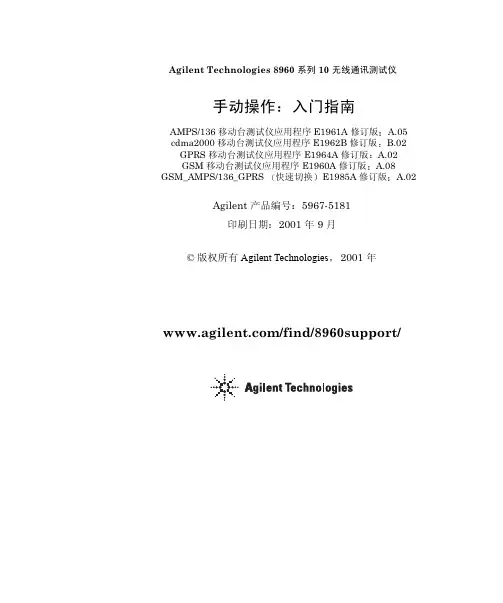
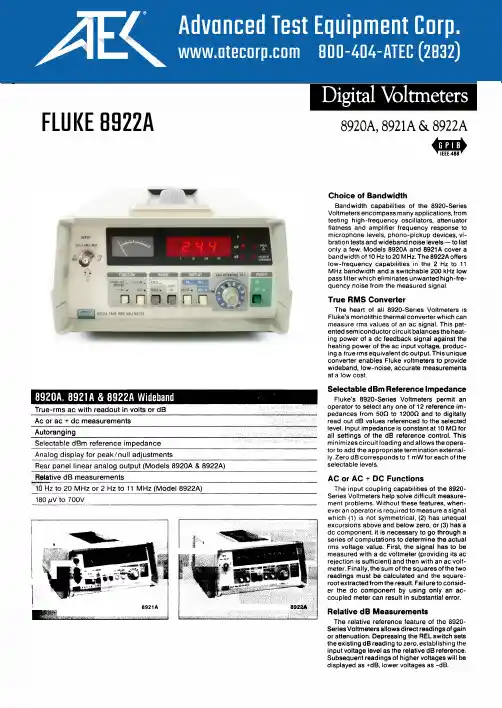
FLUKE 8922A8920A, 8921A & 8922AAutorangingFluke's autoranging feature allows you to carry out your testing without having to change ranges manually. A range can be placed on HOLD or manually stepped up to a higher range. On HOLD, the meter will remain in a given range regardless of changes in input levels. On STEP UP, the meter will increase ranges step-by-step until the switch is released. Peaking/Dipping MeterIn addition to an accurate digital display, all Fluke Voltmeters in the 8920-Series feature an analog meter for peak and null voltage adjustments. The meter indicates O to 100 percent full scale in each range.Linear Analog OutputModels 8920A and 8922A are equipped with a rear panel output for driving X-Y or st d p chart recorders, delivering voltages proportional to the display count. A 2-volt level equals 2000 counts, a 1-volt level equals 1000 counts, etc. This feature is not available on Model 8921A. AccuracyFluke Digital Voltmeters avoid the possibilities for error so common in analog meters. The digital displays eliminate the likelihood of misreading the meter due to viewing angle problems of parallax common with analog meters. Also, the accuracy of 8920-Series Voltmeters is specified as a percent of reading rather than as percent of full scale.Percent of reading accuracy does not degrade for measurements at the low end of a scale. Front panel switching offers a choice of readings in dB or volts.Technical SpecificationsThe a ccuracy s pecifications b elow apply from 9% to 100% of full scale and from 18°C to 28°C for 90 days. For six-month specifications multiply figures by 1.5.AC Accuracy: ± % of voltage reading or ±dB (8920A/8921 A)Range 2Hz 10 H z 20Hz 50Hz 10 kHz 700V200V1%or 0.5%or 20V 0.15dB 0.1 dB 2V Not200mV Speci-5%orlied 0.5dB 2%or 1%or 20 m V 0.25 d B 0.15dB3%or 2%or 2mV0.35dB 0.25dBAC Accuracy: ± % of voltage reading or ±dB(8922A)Range 2Hz 10 H z 20Hz 50Hz 10 k HzFILTER IN I700V200V 1%or•0.15 d B 1%or 0.5%or20V 0.15 d B 0.1 d B2V 5%or200 mV 3%or• 0.5dB0.35dB2%or•0.25dB 2%or 1%or20 mV 0.25 d B 0.15 d B5%or0.5dB5%or• 5%or 3%or 2%or I2 mv0.5 d B .. 0.5dB 0.35 d B 0.25dB• Valid when AC + DC DAMPING is selected andinput has no de components.••Below 2 mV add number of digits (N) to ±5% voltage readings, where N = 5 + mV input. Or, for dBreadings. add N to ±0.5 dB, where N = 0.5 + (mVinput)2AC+DC Accuracy: Add to AC accuracy specifications (above) ±10 digits or ±0.5 dB above 2mV, or ±100 digits or ±5.0 dB below 2 mV. Forde only, add above digits to 50 Hz to 10 kHzspecificationsFunctions: True RMS measurements only. ACor AC+ DC (8920A and 8921 A); AC or AC+ DCwith damping (8922A)Maximum Input: 700V rms or 1 O OOV peak, not toexceed a volt-hertz product of 1 x 108 on anyrangeMaximum Common Mode Voltage8920A and 8922A: 400 mV rms or 600 mVpeak8921A: 500V rms or 700V peakAC Common Mode Rejection: �60 dB at 50 and60 Hz with 1000 unbalanceDC Common Mode Rejection: �100 dB, 1000unbalanceCrest Factor: 7 at full scale, increasing downscale by 7 times the voltage range divided by thevoltage input. Degrades below 10 Hz, annunciated when capability exceeded (8922A only)Input Impedance: 10 MO shunted by <30 pF200kHz 1 MHz 2MHz 10 M Hz 20MHzNot Specified0.7%or0.15 d B3% o r0.35 d B 5%or0.5dB2%or0.25dB 4%or0.4dB I3%or0.35dB200kHz 1 MHz 2MHz 11 MHzFILTER OUTNot Specified0.7%or0.15 d B3%or0.35 d B2%or 5%or0.25 d B 0.5dB4% o r0.4 d BVoltage R11nges: 2 mV, 20 mV, 200 mV, 2V, 20V,200V, 700VRanging: Autoranging with HOLD to defeat a�to•ranging and STEP UP for manual ranging.Ranges up at 2000 counts and ranges down at180 countsDecibel Ranges: In the autorange mode, theinstrument appears as though it has a singlerange spanning 131 dBdBm Reference: Twelve user-selectable impedances are provided to reference a O dBm, 1mW level (500,750,930, 1100, 1240, 1350,1500, 3000, 6000, 9000, 10000, and 12000)(dBV = 10000)Relative dB Reference: A voltage input presentwhen this button is pushed is held as "O dB"reference point. Subsequent readings indicate±deviations from this pointVoltage Resolution: 0.05% of ranges (3½ digits)Decibel Resolution: O.Q1 dB (4½ digits)Typical-3 dB Points: 40 MHz on 20 mV thru 20Vranges and 4 MHz on 2 mV range (8920A/8921 A); 22 MHz on 2 mV to 20V ranges (8922A)Low Pass Filter: Approximately 200 kHz -3 dBpoint, on 8922A onlyReading Rate: 2.5/s or 1 /s with ac + de withdamping (8922A)Autorange Rate: <950 ms or <3.5s with ac + dewith damping (8922A)Response Time: (To rated accuracy) <1.6s or<7s with ac + de with damping (8922A)Readout: Panel-select able for volts or dB,auto•matic decimal point location: analog peaking/dipping meter. " V .. "V .. "dB,,LED Annunciators: Indicate m , ,"REL REF," and "2 MHz MAX" for 2 mV range(8920A and 8921A) and "UNCAL" when crestfactor limitation exceeded (8922A)Overrange: Flashes maximum reading for thatrangeUnderrange: Flashes decimalLinear Analog Output: (8920A and 8922A only)Linear output of 2000 mV de for a 2000-countreadout; ±1.0% relative to display; essentiallyoo output into a �10 kO load; non-isolated, withoutput common same as input common。
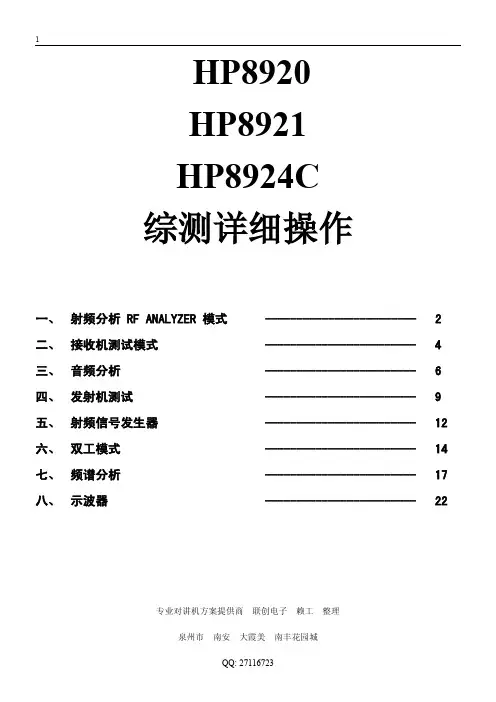
HP8920HP8921HP8924C综测详细操作一、射频分析RF ANALYZER模式------------------------2二、接收机测试模式------------------------4三、音频分析------------------------6四、发射机测试------------------------9五、射频信号发生器------------------------12六、双工模式------------------------14七、频谱分析------------------------17八、示波器------------------------22专业对讲机方案提供商联创电子赖工整理泉州市南安大霞美南丰花园城QQ:27116723一、射频分析RF ANALYZER模式本屏为射频分析RF ANALYZER模式。
用于测试发射机的各种发射参数。
说明如下:一、Tune Mode调谐模式。
可自动Auto和手动Manual。
a)当Tune Mode调谐模式设置为手动Manual时,Tx Frequency以误差形式显示,并显示为TX Freq Error。
b)当Tune Mode调谐模式设置为自动Auto时,Tx Frequency以频率显示。
二、Tune Freq调谐频率。
三、TX Power发射功率。
四、Input Port射频输入口选项。
a)RF In表示射频信号从射频输入/输出口RF IN/OUT进。
通常大功率信号从此口进。
b)Ant表示射频信号从天线输入口ANT IN进。
弱小信号一般从此口进。
五、Input Atten输入衰减。
可选自动Auto和保持Hold。
a)当选自动时,机器根据输入信号的大小,自动选择输入衰减值0dB,20dB或40dB。
b)当选择保持时,衰减值保持不变,可手动选择衰减值。
六、Sensitivity天线输入口ANT IN灵敏度选择。
a)Normal表示正常灵敏度。
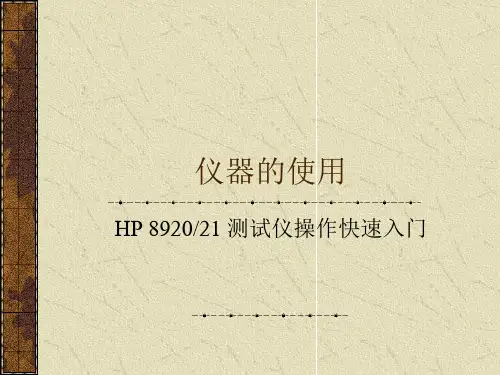
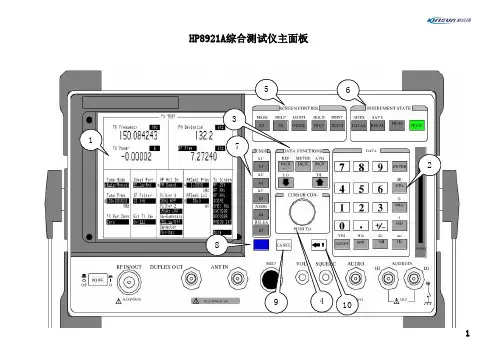
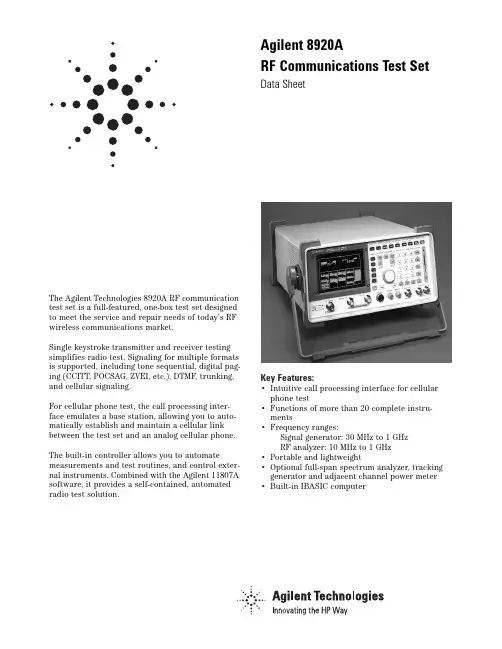
The Agilent Technologies 8920A RF communication test set is a full-featured, one-box test set designed to meet the service and repair needs of today’s RF wireless communications market.Single keystroke transmitter and receiver testing simplifies radio test. Signaling for multiple formats is supported, including tone sequential, digital pag-ing (CCITT, POCSAG, ZVEI, etc.), DTMF, trunking, and cellular signaling.For cellular phone test, the call processing inter-face emulates a base station, allowing you to auto-matically establish and maintain a cellular link between the test set and an analog cellular phone. The built-in controller allows you to automate measurements and test routines, and control exter-nal instruments. Combined with the Agilent 11807A software, it provides a self-contained, automated radio test solution.Key Features:•Intuitive call processing interface for cellular phone test•Functions of more than 20 complete instru-ments•Frequency ranges:Signal generator: 30 MHz to 1 GHzRF analyzer: 10 MHz to 1 GHz•Portable and lightweight•Optional full-span spectrum analyzer, tracking generator and adjacent channel power meter •Built-in IBASIC computerAgilent 8920ARF Communications Test SetData SheetAgilent 8920A RF Communications Test Set SpecificationsSpecifications describe the instrument’s warranted performance and are valid over the entire operating/environmental range unless otherwise noted.Supplemental Characteristics are intended to provide additional information useful in applying the instrument by giving typical, but non-warranted performance parameters. These characteristics are shown in italics or labeled as “typical,” “usable to,” or “nominal.”Signal Generator SpecificationsRF FrequencyFrequency Range:Standard: 30 MHz to 1 GHzOption 055:250 kHz to 1 GHzAccuracy and Stability:Same as reference oscillator ±0.015 Hz Reference Oscillator SpecificationsTCXO(Agilent 8920A standard)Temperature:1 ppm (0 to +55 °C)Aging:<2 ppm/yearWarm-Up time:<30 sec. to be ±2 ppm of final freq. Supplemental CharacteristicsSwitching Speed: <150 ms to within 100 Hz of the carrier frequencyMinimum Resolution:1 HzOutputRF IN/OUT ConnectorLevel Accuracy:±1.8 db (level ≥–127 dBm),Typically ±1.0 dB for all levelsLevel RangeStandard:Level Range:–137 to –20.5 dBm into 50 ΩReverse Power:60 watts continuous,100 watts for 10 seconds/minuteWith Option 007:Level Range:–137 to –6.5 dBm into 50 ΩReverse Power:2.4 watts continuous,4 watts for 10 seconds/minuteWith Option 008:Level Range:–137 to –10.5 dBm into 50 ΩReverse Power:6 watts continuous,10 watts for 10 seconds/minuteWith Option 016:Level Range:–137 to –22.5 dBm into 50 ΩReverse Power:100 watts continuous,125 watts for 10 seconds/minute Option 055:Level Range:–137 to –19 dBm into 50 ΩReverse Power:60 watts continuous,100 watts for 10 seconds/minuteWith Option 007:Level Range:–137 to –5 dBm into 50 ΩReverse Power:2.4 watts continuous,4 watts for 10 seconds/minuteWith Option 008:Level Range:–137 to –9 dBm into 50 ΩReverse Power:6 watts continuous,10 watts for 10 seconds/minuteWith Option 016:Level Range:–137 to –21 dBm into 50 ΩReverse Power:100 watts continuous,125 watts for 10 seconds/minuteDUPLEX OUT ConnectorStandard:Level Accuracy:±1.5 dB, typically ±1.0 dB for all levelsLevel Range:–127 to +5 dBm into 50 ΩReverse Power:200 mW maxOption 055:Level Range:–127 to +7 dBm into 50 ΩSWR:RF In/Out:<1.5:1Duplex Out:<2.0:1 (level <–4 dBm)Supplemental CharacteristicsMinimum Resolution:0.1 dBSpectral PuritySpurious Signals:For specified output levels at DUPLEX OUT port or specified output level at RF IN/OUT port.Option DUPLEX OUT RF IN/OUT Standard≤–2.5 dBm≤–26.5 dBm007≤–2.5 dBm≤–12.5 dBm007 with Opt. 055≤–1.0 dBm≤–11.0 dBm008≤–2.5 dBm≤–16.5 dBm008 with Opt. 055≤–1.0 dBm≤–15.0 dBm016≤–2.5 dBm≤–28.5 dBm016 with Opt. 055≤–1.0 dBm≤–27.0 dBm055≤–1.0 dBm≤–25.0 dBmHarmonics:<–30 dBcNon-Harmonic Spurious:<–60 dBc (at >5 kHz from carrier) Residual FM (rms, CCITT):Frequency Range8920A Standard8920A Opt. 050 250 kHz ≤f c<249 MHz<20 Hz<7 Hz249 MHz ≤f c<501 MHz<10 Hz<4 Hz501 MHz ≤f c≤1000 MHz<20 Hz<7 Hz2SSB Phase Noise: (For >20 kHz offsets at 1 GHz)8920A <–110 dBc/Hz8920A Opt. 050 <–116 dBc/HzFMFM Deviation Maximum (For rates >25 Hz)Standard and Options 007, 008, 016:100 kHz for f c from 30 MHz to <249 MHz50 kHz for f c from 249 MHz to <501 MHz100 kHz for f c from 501 MHz to 1000 MHzOption 055:100 kHz for f c from 0.25 MHz to <249 MHz50 kHz for f c from 249 MHz to <501 MHz100 kHz for f c from 501 MHz to 1000 MHzFM Rate (1 kHz reference)Internal:DC to 25 kHz (1 dB BW)External:AC Coupled: 20 Hz to 75 kHz (typically 3 dB BW)DC Coupled: DC to 75 kHz (typically 3 dB BW)FM Accuracy:(1 kHz rate)≤10 kHz dev: ±7.5% (3.5%*) of setting ±50 Hz>10 kHz dev: ±7.5% (3.5%*) of setting ±500 HzFM Distortion:(THD + Noise, in a 0.3 to 3 kHz BW)<1% (0.5 %*) at > 4 kHz deviation and 1 kHz rateCenter Frequency Accuracy in DC FM Mode:(External source impedance <1 kΩ) ±500 Hz(after DC FM zero), typically ±50 HzSupplemental CharacteristicsExternal Modulation Input Impedance: 600 Ωnominal Resolution: 50 Hz for <10 kHz deviation, 500 Hz for >10 kHz deviationAMStandard:Frequency Range:30 MHz to 1 GHzAM Depth:0 to 90% (usable to 99%) for DUPLEX OUT level ≤–2.5 dBm or RF IN/OUT level ≤–26.5dBm; 0 to 70% (usable to 90%*)Option 055:Frequency Range:1.5 MHz to 1 GHz (usable to 250kHz)AM Depth:0 to 90% (usable to 99%) for DUPLEX OUT level ≤+1 dBm or RF IN/OUT level ≤–27dBm; 0 to 70% (usable to 90%*)AM Rate:20 Hz to 25 kHz (3 dB BW)AM Accuracy:(1 kHz rate)≤10% AM: ±5% of setting ±1.0% AM>10% AM: ±5% of setting ±1.5% AMAM Distortion:(THD+Noise 0.3 to 3 kHz BW)<2% at 1 kHz rate, <30% AM<3% at 1 kHz rate, ≤90% AM External Mod. Input Impedance:600 ΩnominalResidual AM: <0.1% in a 50 Hz to 15 kHz BWResolution: 0.05% AM from 0 to 10% AM, 0.5% AM from 10 to 100% AMAudio Source Specifications(Applicable to both internal sources)FrequencyRange:dc to 25 kHzAccuracy:0.025% of settingSupplemental CharacteristicsMinimum Resolution: 0.1 HzOutput LevelRange:0.1 mV to 4 VrmsMaximum Output Current:20 mA peakOutput Impedance:<1 Ω(1 kHz)Accuracy:±2% of setting plus resolutionResidual Distortion:0.125%(THD plus noise, for amplitudes >200 mVrms), for tones 20 Hz to 25 kHz measured in an 80 kHz BWSupplemental CharacteristicsResolution:Level <0.01V: ±50 µVLevel <0.1V: ±0.5 mVLevel <1V: ±5 mVLevel <10V: ±50 mVOffset in DC Coupled Mode: <50 mVRF Analyzer MeasurementsRF Frequency MeasurementsMeasurement Range:Standard:30 MHz to 1 GHzOption 055:400 kHz to 1 GHzLevel Range:RF In/Out:Standard:1 mW to 60 W continuous 100 W for10 seconds/minuteOption 007:40 mW to 6 W continuous 4 W for10 seconds/minuteOption 008:0.1 mW to 6 W continuous 10 W for10 seconds/minuteOption 016:1.6 mW to 100 W continuous 150 W for10 seconds/minuteANT IN:–36 dBm to +20 dBmAccuracy:±1 Hz plus timebase accuracy3Minimum Frequency Resolution: 1 HzRF Power MeasurementsFrequency Range:Standard:30 MHz to 1 GHzOption 055:400 kHz to 1 GHzSWR:<1.5:1 for standard and all optionsRF IN/OUT Measurement Range:Standard:1 mW to 60 W continuous or to 100 W for10 sec/minuteAccuracy:±10% of reading ±1 mWOption 007:40 µW to 2.4 W continuous 4 W for10 seconds/minuteAccuracy:±10% of reading ±40 µWOption 008:0.1 mW to 6 W continuous 10 W for10 seconds/minuteAccuracy:±10% of reading ±0.1 mWOption 016:1.6 mW to 100 W continuous 125 W for10 seconds/minuteAccuracy:±10% of reading ±1 mWSupplemental CharacteristicsResolution: P >10 W: 10 mW, P <10 W: 1 mW; P <100 mW: 0.1 mW, P <10 mW: 0.01 mWFM MeasurementFrequency Range:Standard:10 MHz to 1 GHzOption 055:5 MHz to 1 GHz (Usable to 400 kHz) Deviation:20 Hz to 75 kHzSensitivity:2 µV (15 kHz IF BW, high sensitivity mode, 0.3 to 3 kHz BW, 12 SINAD, fc >10 MHz) Typically:<1 µVAccuracy:±4% of reading plus residual FM and noise contribution (20 Hz to 25 kHz rates, deviation ≤25kHz)Bandwidth (3 dB):2 Hz to 70 kHz (DC FM measurements also available)Input Level Range for Specified Accuracy:Standard:–50 dBm to +14 dBm at ANT IN –18 to +50 dBm at RF IN/OUT (0.16 mW to 100 W*)Option 007:–32 to +36 dBm at RF IN/OUT (0.63 µW to 4 W*) Option 008:–28 to +40 dBm at RF IN/OUT (1.58 µW to 10 W*) Option 016: –16 to +51 dBm at RF IN/OUT (0.25 µW to 125 W*) *Note: The accuracy shown is for the complete range of power. The maximum power levels shown are only usable for 10sec/min.Residual FM and Noise:20 Hz (0.3 to 3 kHz, rms), <7Hz (with Agilent 8920A Opt 050)Resolution: 1 Hz, f <10 kHz; 10 Hz, f ≥10 kHzAM MeasurementFrequency Range:10 MHz to 1 GHz (usable to 400 kHz) Depth:0 to 95%Accuracy:±5% of reading ±1.5% AM (50 Hz to 10 kHz rates, mod-ulation ≤80%)THD + Noise:<2% rms for modulation ≤80% AM (at 1 kHz rate in a 0.3 to 3 kHz BW)Input Level Range for Specified Accuracy:Standard:–50 dBm to +14 dBm at ANT IN –18 to +50 dBm at RF IN/OUT (0.16 mW to 100 W*)Option 007:–32 to +36 dBm at RF IN/OUT (0.63 µW to 4 W*) Option 008:–28 to +40 dBm at RF IN/OUT (1.58 µW to 10 W*) Option 016:–16 to +51 dBm at RF IN/OUT (0.25 µW to 125 W*) *Note: The accuracy shown is for the complete range of power. The maximum power levels shown are only usable for 10 sec/min. Residual AM:<0.2% in a 0.3 to 3 kHz bwSupplemental CharacteristicsResolution: 0.1%SSB MeasurementFrequency Range:Standard:10 MHz to 1 GHzOption 055:400 kHz to 1 GHzBandwidth (3 dB):20 Hz to 70 HzDistortion and Noise:<3% (at 1 kHz rate in a 0.3 to 3 kHz BW)AF Analyzer SpecificationsFrequency MeasurementMeasurement Range:20 Hz to 400 kHzAccuracy:±0.02% plus resolution plus timebase accuracy External Input:20 mV to 30 VrmsSupplemental CharacteristicsResolution:0.01 Hz, f <10 kHz; 0.1 Hz, f <100 kHz; and 1 Hz forf ≥100 kHzAC Voltage MeasurementMeasurement Range:0 to 30 VrmsAccuracy:±3% of reading (20 Hz to 15 kHz, inputs >1 mV) Residual Noise:150 µV (15 kHz bandwidth)43 dB Bandwidth: Typically 2 Hz to 100 kHzNominal Input Impedance: Switchable between1 MW in parallel with 95 pF or 600 ΩfloatingMinimum Resolution:4 digits for inputs ≥100 mV; three digits for inputs <100 mVDC Voltage MeasurementVoltage Range:100 mV to 42 VAccuracy:±1% of reading plus DC offsetDC Offset:±45 mVSupplemental CharacteristicsResolution:1 mVDistortion MeasurementFundamental Frequency:1 kHz ±5 HzOption 019 Frequency Range:0.3 to 10 kHz ±5%Input Level Range:30 mV to 30 VrmsDisplay Range:0.1% to 100%Accuracy:±1 dB (0.5 to 100% distortion) for tones from 300 to 1500 Hz measured with the 15 kHz LPF±1.5 dB (1.5 to 100% distortion) for tones from 300 Hz to 10 kHz measured with the >99 kHz LPF)Residual THD + Noise:–60 dBc or 150 µV whichever is greater, for tones from 300 to 1500 Hz measured with the 15 kHz LPF–57 dBc or 450 µV, whichever is greater, for tones from 300 Hz to 10 kHz measured with >99 kHz LPF)Supplemental CharacteristicsResolution: 0.1% distortionSINAD MeasurementFundamental Frequency:1 kHz ±5 HzOption 019 Frequency Range:0.3 to 10 kHz ±5%Input Level Range:30 mV to 30 VrmsDisplay Range:0 to 60 dBAccuracy:±1 dB (0 to 46 dB SINAD) for tones from 300 to 1500 Hz measured with the 15 kHz LPF±1.5 dB (0 to 36 dB SINAD) for tones from 300 Hz to 10 kHz meas-ured with the >99 kHz LPFResidual THD + Noise:–60 dBc or 150 mV, whichever is greater, for tones from 300 to 1500 Hz measured with the 15 kHz LPF–57 dBc or 450 mV, whichever is greater, for tones from 300 Hz to 10 kHz measured with >99 kHz LPF Resolution: 0.01 dBAudio FiltersStandard:<20 Hz HPF, 50 Hz HPF, 300 Hz HPF 300 Hz LPF, 3 kHz LPF, 15 kHz LPF, >99 kHz LPF, and 750 µsec de-emphasisFixed Notch:1 kHz, (Agilent 8920A standard)Variable Notch:300 Hz to 10 kHz (Option 019)Optional:C-Message, CCITT, 400 Hz HPF, 4 kHz BPF, 6 kHz BPF (see options)Audio Detectors: RMS, RMSxSQRT2, Pk+, Pk–, Pk+hold, Pk–hold, Pk±/2, Pk±/2 hold, Pk±max and Pk±max hold Oscilloscope SpecificationsFrequency Range:2 Hz to 50 kHz (3 dB BW)Scale/Division:10 mV to 10 VAmplitude Accuracy:±1.5% of reading ±0.1 division(20 Hz to 10 kHz)Time/Division:1 µsec to 200 msecSupplemental Characteristics3 dB Bandwidth: Typically >100 kHzInternal DC Offset: ≤0.1 div (≥50 µV/div sensitivity)Input and Output SpecificationsDigital Interface PortRS-232 port:2 wayConnector: RJ-11connector (6 pins; 2 addressable serial ports with single connector; Agilent 8920A rear panel)Baud Rates:300/600/1200/2400/4800/9600/19200Reference In PortConnector:BNC female (8920A rear panel)Input frequency:1/2/5/10 MHzInput Level Range:>0.15 VrmsReference Out PortConnector:BNC female (8920A rear panel)Output Frequency:10 MHzOutput Level: >0.5 VrmsStandard User Memory, RAMApproximately 1 Mbyte of RAM is available for nonvolatilesave/recall of settings. This typically will allow you to save >1000 sets of instrument settings; depending on the type of information saved.5Option SpecificationsOption 001: High Stability TimebaseOCXO: (Oven controlled crystal oscillator)Temperature:0.05 ppm (0 to +55 °C)Aging:<0.5 pm/year (<1 ppm in first year)Warm-up Time:<15 minutes to be within ±0.1 ppm of finalfrequencySupplemental CharacteristicsRear Panel BNC Connectors:Input Frequency: 1, 2, 5, and 10 MHzInput Level: >0.15 VrmsOutput Frequency: 10 MHzOutput Level: >0.5 VrmsOption 004: Tone/Digital SignallingCapability for generating and analyzing the formats listed here: CDCSS, DTMF, 1-TONE, 2-TONE, 5/6 TONE SEQUENTIAL, RPC1, POCSAG, EIA, CCITT, CCIR, ZVEI, DZVEI, GOLAY, EEA, NMT-450, NMT-900, LTR, AMPS/EAMPS/NAMPS, TACS/ETACS,JTACS/NTACS, EDACS, and MPT 1327.A General Purpose function generator with the following wave forms included:Sine, square, triangle, ramp, Gaussian white noise, uniform white noiseFrequency Range/Level:Same as audio sourceOption 007 and Low-Level RF Power MeasurementsOption 007 removes a 14 dB attenuator at the RF IN/OUT port allowing lower-level, higher sensitivity measurements. This option reduces the maximum continuous input power of the Agilent 8920A from 60 watts to 2.4 watts. Specifications for Option 007 are included in the appropriate sections of: Signal Generator out-put, RF Analyzer, Frequency and Power Measurement Ranges, FM and AM Measurement Input Level Ranges.Option 008 Cellular Mobile RF Power Measurement RangeOption 008 removes 10 dB attenuation at the RF IN/OUT port allowing lower-level, higher sensitivity measurements specifically for the range of cellular telephones testing. This option reduces the maximum continuous input power of the 8920A from 60 watts to 6 watts. Specifications for Option 008 are included in the appro-priate sections of: Signal generator output, RF analyzer, frequency and power measurement ranges, FM and AM measurement input level ranges.Option 010: 400 Hz High Pass FilterOption 011: CCITT Weighting FilterOption 012: 4 kHz Bandpass Filter Option 013: C-Message Weighted FilterOption 014: 6 kHz Bandpass FilterOption 016 High-Level RF Power Measurements Option 016 for the 8920A supports high-power transmitter meas-urement applications. Option 016 can only be ordered on a new instrument at the time of purchase. Option 016 can only be installed at the factory.Option 019: Variable Notch FilterFrequency Range:300 Hz to 10 kHzNotch Depth:>60 dBNotch Width:Typically ±5%Option 020: Radio Interface CardThe Option 020 for the 8920A is a built-in radio interface card for automating module and radio board test. It contains 16 parallel data lines, two interrupts, and brings the audio in/out lines and a relay closure out from the MIC/ACC connector on the front panel. These are controlled by the 8920A BASIC control language. Line Levels:5 volts or 12 voltsOption 050: Improved Residual FM Performance Includes high stability timebase (Option 001), improved residual FM performance.Option 102: Spectrum Analyzer with Tracking Generator and ACPFrequency Range:10 MHz to 1 GHzFrequency Span/Resolution Bandwidth:(coupled)Span Bandwidth<50 kHz300 Hz<200 kHz 1 kHz<1.5 MHz 3 kHz<18 MHz30 kHz>18 MHz300 kHz, plus full span capabilityDisplay:Log with 1, 2, and 10 dB/divDisplay Range:80 dBReference Level Range:+50 to –50 dBmResidual Responses:<–70 dBm (no input signal, 0 dB attenuation)Image Rejection:>50 dBmSupplemental CharacteristicsNon-Harmonic Spurious Responses: >70 dB down (for input sig-nals ≤–30 dBm)6Level Accuracy: ±2.5 dBDisplayed Average Noise Level: <–114 dBm for <50 kHz spans Log Scale Linearity: ±2 dB (for input levels ≤–30 dBm and/or 60 dB rangeTracking Generator (In Option 102)Frequency Range:30 MHz to 1 GHzFrequency Offset:Frequency span endpoints ±frequency offset cannot be <30 MHz or ≥1 GHzOutput Level Range:Same as signal generatorSweep Modes:Normal and invertedAdjacent Channel Power (In Option 102) Relative Measurements:Level Range:Antenna IN:–40 dBm to +20 dBmRF/Input:0.16 mW (–8 dBm) to 60 W (47.8 dBm)continuous; or up to 100 mW (50 dBm) for 10 sec/min Dynamic Range:Typical values for channel offsetsChannel Offset Res. BW Dyn. Range12.5 kHz8.5 kHz–65 dBc20 kHz14 kHz–68 dBc25 kHz16 kHz–68 dBc30 kHz16 kHz–68 dBc60 kHz30 kHz–65 dBcRelative Accuracy:±2 dBAbsolute Level Measurements:Level:(Results of absolute power in watts or dBm are met by adding the ACP ratio from the SA to the carrier power from the input section RF power detector).Level Range:Antenna:N/ARF/Input:1 mW (0 dBm) to 60 W (47.8 dBm) continuous; or up to 100 W (50 dBm) for 10 sec/minDynamic Range:Typical values for channel offsetsChannel Offset Res. BW Dyn. Range12.5 kHz 8.5 kHz–65 dBc20 kHz 14 kHz–68 dBc25 kHz 16 kHz–68 dBc30 kHz 16 kHz–68 dBc60 kHz 30 kHz–65 dBcAbsolute Accuracy:RF power measurement accuracy found in the RF Analyzer section and ACP relative accuracy of ±2 dB Option 103: DC Current Sensing and I/O:GPIB/RS-232/Parallel (Centronics)DC Current MeterMeasurement Range:0 to 10 A (usable to 20 A)Accuracy:The greater of ±10% of reading after zeroing or 30 mA (levels >100 mA)Remote ProgrammingGPIB:Agilent’s implementation of IEEE Standard 488.2 Functions Implemented:SH1, AH1, T6, L4, SR1, RL1, LE0, TE0, PP0, DC1, DT1, C4, C11, E2RS-232:Two serial ports through RJ-11 connector used for serial data in and outBaud Rates:150, 300, 600, 1200, 2400, 4800, 9600 and 19200 Hz Parallel (Centronics) Connector: A standard 25-pin, sub-min D female connector with right-angle adapter is includedNote: Retrofittable only for 8920A units with serial prefix numbers of 3501 or greaterGeneral Specifications8920A Dimensions:H ϫW ϫD in inches and (mm): 7.5 H ϫ13 W ϫ19 D (188 H ϫ330 W ϫ456 D)8920A Weight:(fully optioned) 37 lbs. (16.8 kgs)8920A Power:AC: 100 V to 240 V, 48 to 440 Hz, nominally 80 wattsDC: 11 to 28 V, nominally 120 watts8920D Power:AC: 100 V to 240 V ±10%, 48 Hz to 440 Hz, nominally 100 watts CRT Size:7 ϫ10 cmOperating Temperature:0 to +55 °CStorage Temperature:–55 to +75 °CCalibration Interval:Two yearsSupplemental CharacteristicsLeakage: At signal generator output frequency and level <–40 dBm, typical leakage is <0.5 µV induced in a resonant dipole antenna one inch from any surface except the rear panel. Spurious leakage levels are typically <1 µV in a resonant dipole antenna.7H i g h S t a b i l i t y T i m e b a s eS i g n a l i n gL o w -P o w e r M e a s u r e m e n tC e l l u l a r M S R F P o w e r R a n g e400 H z H i g h -P a s s F i l t e rC C I T T W e i g h t i n g F i l t e r4 k H z B a n d p a s s F i l t e rC -M e s s a g e W e i g h t i n g F i l t e r6 k H z B a n d p a s s F i l t e rV a r i a b l e F r e q u e n c y F i l t e rM e c h a n i c a l A t t e n u a t o rS p e c r u m A n a l y ./T r a c k i n g G e nG P I B /R S -232 P a r a l l e l11807A R a d i o T e s t S o f t w a r e (O p t i o n s )Automated FM Radio Test 3O O O O O O 001Automated φm Radio Test 3O OOOO 002Automated AM Radio Test OO003Testing Communications Bandwidths <30 MHz XCordless Phone Test 3OOXOFrequency Scanning O Cable Fault Location 2X O Field Strength Measurement XO 100Intermodulation Prod. Cal.O Save/Recall Procedure OLTR Trunked Radio Test 3(Includes FM radio tests)O X X O O O 010EDACS Trunked Radio Test 3(Includes FM radio tests)O X O O O O 011MPT 1327 Trunked Radio Test 3O X OO OO 012AMPS/EAMPS/NAMPS O X OO O O 004TACS/ETACS O X O OO O 005NMT 450/900O X O OO O 006JTACS/NTACSOXOOO007Configuration InformationX = Required Option O = Recommended Option 8920A Options00100400710081010011012013014019055102103M e a s u r i n g C a p a b i l i t yT r u n k e d R a d i oC e l l u l a r P h o n e T e s t1.Options 007 and 008 reduce the maximum input power of the 8920A from 60 watts to2.4 and 6 watts respectively. Option 008 is recommended for applications where the 8920A is used for cellular phone test only.2.Requires an external power divider and 50 ohm load to make measurement.3.Testing frequencies below 30 MHz will require ordering Option 055 (400 kHz to 1 GHz).By internet, phone, or fax, get assistance with all your test and measurement needs.Online Assistance/find/assistProduct specifications and descriptions in this document subject to change without notice.Copyright © 1994, 2000 Agilent Technologies Printed in U.S.A. 10/005968-5385EFor more information, visit our website at:/find/8920support/。

Agilent8920/8921通信测试仪(综测)使用说明一、仪器面板键盘操作及菜单1、面板CRT显示●RX TEST—接收机测试屏幕,可显示RF和AF控制及接收机测试结果。
●TX TEST—发射机测试屏幕,可显示RF和AF控制及发射机测试结果。
●DUPLEX TEST—双工测试屏幕,可同时显示RF和AF控制及收发信机测试结果。
●TESTS—访问来自存储卡、内部ROM/RAM及外接磁盘驱动器装入的程序,可对其编辑与自动运行的屏幕,显示测试结果。
●RF GENERATOR—射频信号源屏幕,用于显示射频与调制信号的控制及测试结果。
●RF ANAL YZER—射频分析仪屏幕,用于显示射频与解调信号的控制及测试结果。
●AF ANAL YZER—音频分析仪屏幕,用于显示音频信号的控制与测试结果。
●OSCILLOSCOPE—示波器屏幕,用于完成对示波器的控制及显示测量结果。
●SPECTRUM ANAL YZER—频谱分析仪屏幕。
●SIGNALING ENCODER—信令编码器屏幕。
●SIGNALING DECODER—信令解码器屏幕。
●RADIO INT—无线电接口与屏幕,显示仪器内置无线电接口卡对外接模块与设备的自动测试结果。
2、面板连接器与控制器●POWER—仪器的电源开关键。
●RF IN/OUT连接器—是一阻抗为50Ω的N型阴性插座,用作射频信号源的输出与调制分析仪的输入接口,允许连续输入60W,或输入100W功率。
●DUPLEX OUT连接器—是一阻抗为50Ω的BNC型阴性插座,用作射频信号源及跟踪信号源的输出端口。
●ANT IN连接器—用作小功率射频信号(≤200Mw)及空中信号的输入端口。
●MIC/ACC接口—是一8针DIN接口,可提供多种用途的连接:MIC IN—当KEY IN接地时去调制射频发生器(先滤波与放大);KEY IN—用于射频信号源的输出开/关状态控制,及在TX TEST与RX TEST屏幕之间的转换控制;KEY OUT1与KEY OUT2用于一部外设的开/关控制。
HP8920/8921使用说明一、主要功能1.信号发生器:HP8920/8921可以生成多种模拟和数字调制的信号,如AM、FM、带宽调制、群组编码、数字调幅等,可模拟各种通信系统所需的信号。
2.信号接收器:HP8920/8921能接收和分析各种调制信号,如FM、PM、AM、数字调制等,并提供实时功率、频谱和误码性能的测量结果。
3.频谱分析仪:HP8920/8921具备高精度频谱测量功能,可以测量多种信号的频率、偏移、谱纹、总谱和谱线等参数。
4.误码仪:HP8920/8921能提供误码性能的测量,包括误码率、误码秒数、比特误码率等指标。
5.对话功能:HP8920/8921可以进行双向对话,支持内置话筒和扬声器,方便进行通信测试。
二、使用方法1.设置信号源:使用菜单或快捷键设置HP8920/8921的信号源参数,包括频率、功率、调制方式等。
2.设置信号接收:使用菜单或快捷键设置HP8920/8921的接收参数,如频率范围、带宽、接收灵敏度等。
3.发射信号:在信号源菜单中选择信号类型和参数,并将发射天线与接收天线相连,发射信号。
4.接收信号:选择菜单中的接收模式,如FM、AM等,接收并分析信号。
5.频谱分析:选择频谱分析仪功能,输入待测信号,HP8920/8921将自动显示频谱和相关参数。
6.误码测量:选择误码仪功能,输入待测信号,HP8920/8921将自动统计并显示误码率和误码秒数。
7.对话测试:选择对话功能,进行双向通信测试,可以通过内置话筒和扬声器进行对话。
三、注意事项1.在进行测试前,请先根据测试要求设置相关参数,并连接好天线和输入输出设备。
2.执行项功能前,请确保已经选择了正确的模式,并根据提示操作。
3.在进行频谱测量时,需注意选择合适的分析带宽和显示方式,以获得准确的结果。
4.在进行误码测量时,确保输入信号质量和中断率,并选择合适的测量时长和统计方式。
四、如何获取更多信息1.参考用户手册:HP8920/8921配有详细的用户手册,其中包含了更多详细的功能和操作说明。
HP8920HP8921HP8924C综测详细操作一、射频分析RF ANALYZER模式------------------------2二、接收机测试模式------------------------4三、音频分析------------------------6四、发射机测试------------------------9五、射频信号发生器------------------------12六、双工模式------------------------14七、频谱分析------------------------17八、示波器------------------------22专业对讲机方案提供商联创电子赖工整理泉州市南安大霞美南丰花园城QQ:27116723一、射频分析RF ANALYZER模式本屏为射频分析RF ANALYZER模式。
用于测试发射机的各种发射参数。
说明如下:一、Tune Mode调谐模式。
可自动Auto和手动Manual。
a)当Tune Mode调谐模式设置为手动Manual时,Tx Frequency以误差形式显示,并显示为TX Freq Error。
b)当Tune Mode调谐模式设置为自动Auto时,Tx Frequency以频率显示。
二、Tune Freq调谐频率。
三、TX Power发射功率。
四、Input Port射频输入口选项。
a)RF In表示射频信号从射频输入/输出口RF IN/OUT进。
通常大功率信号从此口进。
b)Ant表示射频信号从天线输入口ANT IN进。
弱小信号一般从此口进。
五、Input Atten输入衰减。
可选自动Auto和保持Hold。
a)当选自动时,机器根据输入信号的大小,自动选择输入衰减值0dB,20dB或40dB。
b)当选择保持时,衰减值保持不变,可手动选择衰减值。
六、Sensitivity天线输入口ANT IN灵敏度选择。
a)Normal表示正常灵敏度。
仪器名称 综合测试仪功 能 电气测试文件编号仪器型号厂 商版 本 一、面板介绍:1. POWER :电源开关2. LCD 显示屏:显示测试画面B HOST 接口:用于拷贝资料4. 蜂鸣器口:用于发出OK 与NG 声响5.功能键:不同显示画面对应不同功能6. 调用测试文件功能键:用于调取测试资料7.MEAS 键:按此键可直接进入测试界面8.SUTEP 键:按此键可直接进入测量设置界面9.SYSTEM 键:系统设置界面 10.数值键:用于向仪器输入数据11.ESC 键:退出功能 12.BACKSPACE 键:用于删除输入数值最后一个键 13.CAL 键:可选择对扫描测试开路、短路校准 14.KEYLOCK 键:开、解锁键 15.DC BIAS 键:用于允许和禁止直流偏置输出16.RESET 键:复位键,当变压器扫描测试进行时,按下此键即停止扫描17.TRIGGER 键:触发按键,当仪器触发方式设定为MAN (手动)模式时,按此键可触发仪器测试 18.连接扫描盒前端口:用于仪器连接扫描盒进持扫描测量 19.ENTEN 键:用于终止输入数据输入 20.光标键:进行光标移动选择所需项目21.机壳接地端:该接线端于仪器机壳相连。
用于保护或屏蔽接地连接22.功能键:复合功能键。
当变压器扫描显示页面,插上U 盘按此键,可选择拷全屏或保存测试数至U 盘;当变压器设置页面,可快速的切换变压器测试页面核 准 审 核 制 作 日 期4321567 8 910110 120130140 150 160 170 18192021 22仪器名称 综合测试仪功 能 电气测试文件编号 仪器型号厂 商版 本二、操作说明:1.仪器、扫描盒、治具的连接如下图:23.连接扫描盒前端口:用于扫描盒连接仪器 24.扫描盒:由仪器控制其扫描测量 25.脚踏板开关: 26.综合测试治具27.SCANNER :控制端口,用专用电缆线将扫描盒SCANNER 接口与仪器SCANNER 接口相连接 28.专用电缆线:用于仪器与扫描盒的连接 29.电源线:用于接通220V/50HZ 的电压 30.SCANNER 接口:通过SCANNER 接口控制变压器扫描盒2.仪器的开机:接通220V/50HZ 电源后,按下如图“1”电源开关按键后再按MEAS 键进入变压器测试界面。
HP8920A/B综合测试仪使用方法
一、测试线的连接
MAX PWR 60W——仪器射频信号输入输出(注意观察标注的最大功率值,可能有些仪器只能测试5W或者10W的功率)。
接被测试机器的天线头。
(此处不能接错!200mw的那个头不要输入大功率,否则,会损坏仪器!)
AUDIO IN (HI)——音频信号输入(接对讲机外接耳机插孔,输入信号后仪器显示相应指标)。
AUDIO OUT——音频信号输出(接对讲机外接话咪插孔,仪器里面模拟出来的音频信号经过话咪插孔进入到对讲机里面进行调制,然后通过仪器显示相关指标)。
其它部分按钮说明:VOLUME:调节仪器蜂鸣器声音大小。
SQUELCH:旋钮上的色点一般调节在中心位置合适,不然,有噪声。
二、测试
1、发射测试(检测机器时,一般先测发射,因为发射部分的一些指标不良,会影响到
接收):按仪器面板上的“TX”按键,进入发射指标检测界面。
连接好对讲机各测
试线并打开电源,按下对讲机的PTT按键,发射时,主要看仪器屏幕上的三个指标:Tx Frequency :频率误差(实际发射出来的频率值和该信道标称频率的
差值,一般±500Hz即可。
Tx Power:功率大小
FM Deviation:最大频偏(一般在4KHz左右,加亚音频之后,会高
0.7KHz。
该指标影响对讲机的送话)。
在发射状态下,把仪器的滤波器调小:即把“Filter 1”选择到“<20Hz”,再把“Filter 2”选择到“300Hz”,即可以在“FM Deviation”这一栏直接查看到该
信道所加的模拟亚音频数值。
2、接收测试:按仪器面板上的“RX”按键,在该界面,要设置以下参数:转动面板
上的那个大的旋钮,让光标停留在“RF Gen Freq”处,直接按数字键和单位按键,即输入要测试对讲机的接收频率(如458.825MHz),然后,再把光标移到“Amplitude”
这一项,分别输入1mv和0.25uv两种场强参数(看你自己的习惯,也可以用“-
DBm”的单位),以检测机器的失真度和灵敏度。
设置好后,如果机器正常,喇叭
会发出声音,用耳机测试线插入耳机插座,仪器里面则可以显示出接收机的参数:“SINAD”表示对讲机接收的失真度(场强为1mv时)和灵敏度(信号场强为0.25uv时,这个参数一般大于12dB为正常(越大越好),失真度一般在30dB左右就可以(当音量调为1V以下时看这个指标,越大越好)。
“AC Level”显示接收声音的大小,受音量开关控制,调到最大音量一般在3V左右。
三、亚音/数字亚音频的设置:当机器加了亚音频时,需要在仪器里面设置相应参
数,对讲机才可以正常解调出音频参数,然后喇叭发出声音。
在RX接收测试界面,将光标移到“AF Gen2 Frea”,把该参数改成实际的亚音频率(如67Hz),再把光标移到下面“AF Gen2 TO”的“Off”一项,改为500Hz(固定的参数)即可。
这里只能测试模拟亚音,如果要测试数字亚音的解码功能,则需在另外一个界面进行设置。
请见后面的描述。
1、数字亚音编码的设置:在RX接收测试界面,把接收频率和场强设置好,然后,把
光标移到仪器右边的“To Screen”,选择“ENCODER”——右边“Mode”选项,
选择“CDCSS”——在屏幕的左上角“Code”输入你要测试的数字亚音(如074)
——“Send Mode”选择“cont”——“AF Gen To”下的“FM”输入“500Hz”(固
定的数据)——“Polarity”选择“Norm”或者“Invert”(即测试亚音的正反向)。
其它选项默认即可,此时,如果接收机正常,则可解调出数字亚音,喇叭发出声音。
2、数字亚音解码的设置(即在不知道对讲机该信道数字亚音的情况下,如何测试出它
的参数):在TX发射测试界面,把光标移到仪器右边的“To Screen”,选择
“DECODER”——Arm Meas 下面选择到“cone”——“AF Anl In”这一项选择
到“FM Demod”——“In Put Level”输入“500Hz”。
这时候发射被测试机器,则
在左边的窗口从上至下会显示三排数字,第一排数字即为数字亚音。
如果显示不对
或者数字不稳定,则把“Polarity”选择成“Invert”。
3、示波器:把光标移到仪器右边的“To Screen”,选择“SCOPE”。
进入这个里面后,
象普通示波器一样调整个别参数,便于查看波形即可。
4、频谱仪:把光标移到仪器右边的“To Screen”,选择“SPEC ANL”。
进入到这个界
面后,主要设置好所测试参数的中心频点及带宽,便于查看频谱状况即可。
四、仪器界面的保存
当设置好一个界面后,以后有可能经常会用到这个界面,我们可以把这个界面存储起来,下次使用时,直接调出即可,不用每次都去设置。
步骤:在设置好的界面,按挨着屏幕的一个绿色存储按键“SHIFT”,然后再按上面一排按键中的“RECALL”,这时,结合中间的那个大旋钮,选择好便于记忆的字母或者数字(通过旋转中间的那个大旋钮选取字母,注意:每选取一个要点击一下旋钮。
如:TX-150、RX-SQ等),选择完毕后,移动光标到右边菜单最上面的“Done”确定即可。
下次要使用的这个界面,则按“RECALL”,通过旋转大旋钮让光标停留在设置的快捷菜单上,点击大旋钮确认即可。
如果要删除这个快捷菜单,让光标停留在这个菜单上,按两次“ON/OFF”按键即可删除。
以上介绍的属于HP8920A/B综合测试仪最基本的一些应用,这个仪器的功能比较多(可能有些功能需要选件卡的支持),对于一般的对讲机、车台的测试,掌握到以上的方法就可以了,若想要了解更多测试,可参考仪器光盘里面的说明书。